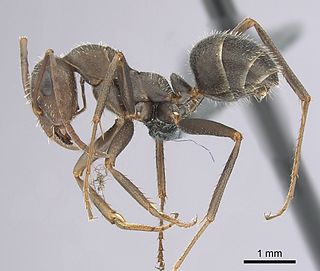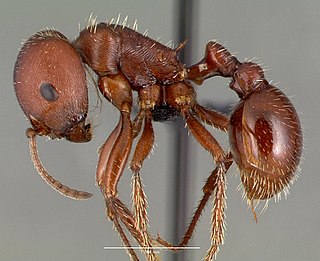
Adetomyrma is a genus of ants endemic to Madagascar. Workers of this genus are blind. The type species Adetomyrma venatrix was described in 1994, with the genus being an atypical member of its tribe, the Amblyoponini. This tribe includes the Dracula ants, members of which can feed on the hemolymph of larvae and pupae.
Temnothorax sentosus is a species of ant in the genus Temnothorax, that is native to Kazakhstan.
Temnothorax inquilinus is a species of ant in the genus Temnothorax native to Ukraine.

Monomorium is a genus of ants in the subfamily Myrmicinae. As of 2013 it contains about 396 species. It is distributed around the world, with many species native to the Old World tropics. It is considered to be "one of the more important groups of ants," considering its widespread distribution, its diversity, and its variety of morphological and biological characteristics. It also includes several familiar pest species, such as the pharaoh ant and the flower ant.

Myrmoxenus is a genus of ants in the subfamily Myrmicinae. The genus was synonymized under Temnothorax by Ward et al. (2015), but the change was not accepted by Heinze et al. (2015) due to insufficient available data.

Pseudomyrmex is a genus of stinging, wasp-like ants in the subfamily Pseudomyrmecinae. They are large-eyed, slender ants, found mainly in tropical and subtropical regions of the New World.

Agroecomyrmecinae is a subfamily of ants containing two extant and two fossil genera. The subfamily was originally classified in 1930 by Carpenter as Agroecomyrmecini, a Myrmicinae tribe. Bolton raised the tribe to subfamily status in 2003, suggesting that Agroecomyrmecinae might be the sister taxon to Myrmicinae. It has since been discovered to be one of the earliest lineages of ants, a clade from the basal polytomy for all ants. In 2014, the subfamily was expanded to two tribes. The tribe Ankylomyrmini was moved from the subfamily Myrmicinae to Agroemyrmecinae.

Myrcidris is a genus of ant in the subfamily Pseudomyrmecinae containing a single species, Myrcidris epicharis. The genus is known only from a few localities north of Manaus, Brazil.

Leptanilloides is a genus of ants in the subfamily Dorylinae. Leptanilloides is an uncommonly collected genus with subterranean habits in the New World Andean and sub-Andean tropics.

Ankylomyrma is a genus of large arboreal ants in the subfamily Agroecomyrmecinae. It contains the single species Ankylomyrma coronacantha, the sole member of the tribe Ankylomyrmini. The genus is known from Africa. Nothing is known about their biology. The genus was moved from the subfamily Myrmicinae to Agroecomyrmecinae in 2014.

Lenomyrmex is a Neotropical genus of ant in the subfamily Myrmicinae.

Pheidole antipodum is a species of ant in the genus Pheidole. It is known only from Australia, where the ants nest in drier regions in soil or under rocks. Little is known about their biology, but they are thought to be specialist predators of termites.

Alloformica is a genus of ants in the subfamily Formicinae. The genus was first described as a subgenus of Proformica by Dlussky (1969), later to be synonymized under Proformica by Brown (1973), and finally revived and raised to genus rank by Dlussky & Fedoseeva (1988). Its species are known only from a few localities.

Iberoformica is a small genus of ants in the subfamily Formicinae.

Veromessor is a genus of ants in the subfamily Myrmicinae. The genus was previously classified as a synonym of Messor, but was revived as a genus by Ward et al. (2015).

Pogonomyrmecini is a tribe of myrmicine ants with 3 extant genera, recently formed in 2015.

Trichomyrmex is a genus of ants in the subfamily Myrmicinae. Described by Mayr in 1865, it was raised as a genus in 2015. These ants are endemic to multiple continents.
Condylodon is a genus of ant with an uncertain placement in the family Formicidae. It contains the single species Condylodon audouini, first described from a single specimen by Lund (1831) in a paper on Brazilian ants.














